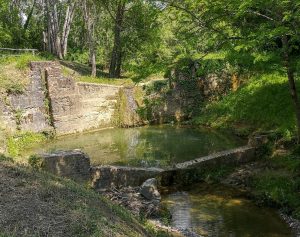Instructions for walking the loop trail from Fattoria di Spoiano – Torrente Agliena- Barberino Val d’Elsa.
There are places that, despite their charm, remain little known. One such place is the Agliena stream, which, with its 27 weirs dating back to the 11th century, forms an interesting natural and historical path.
TREKKING AGLIENA > MAP OF PATH CAI 457
Starting from the gate of Villa di Spoiano, walk up along the cypress-lined avenue. At the white and red marker, turn right. At the fork, turn left, and after the vineyard, turn right again. Continue straight ahead until you reach the valley floor.
Leave Barberino on your left and continue straight along the stream. You will pass by vineyards, woods, Pliocene sands and clays. At the so-called “horse’s leap” (a cliff), you can find seashells dating back millions of years.
All the hiking trails in the municipality of Barberino Tavarnelle > HERE
When you reach the walnut grove, you have to cross the electric fence for a few metres. Cross the ford to get to the other side of the stream.
IMPORTANT: Open and close electric fences by touching the rubber handles. Fences must ALWAYS be closed.
Continue further along the stream. Along this stretch you will find several signs with explanations of the weirs and pictures of the restoration.
At a fork in the road, turn left and cross another ford. The stream will now be on your right. When you arrive at the La Spinosa farm, start climbing along the asphalt and then dirt road that leads to the village of Barberino val d’Elsa. After crossing the village, you will find yourself on a panoramic straight road. At the roundabout, take the cycle path until you reach Strada di Spoiano. Turn left to return to the villa.
What are the Agliena “briglie”?
Weirs are constructions designed to regulate the flow of water in the Agliena stream. They slow down the flow of water during rainy periods and retain it in reservoirs during periods of low rainfall. Most of the weirs in our valley date back to the Middle Ages. They were built to provide farmers, mills and the ancient town of Semifonte with a constant supply of water. After hundreds of years of use, they were abandoned around the 18th century.

The Agliena weirs are among the oldest hydraulic works in our area and were even studied by Leonardo Da Vinci. In the Leicester Codex (1504-1508), the codex containing the scientist’s hydraulic studies, we find mention of the Ghienna stream (toponym of Agliena) and the description of the ingenious constructions to regulate the flow of water.

